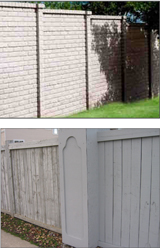Screening fences
Screening fences first appeared in Calgary subdivisions during the late 1970s. They are typically constructed in wood, stucco, concrete, brick and/or stone. These fences provide a shield between private residences and public spaces while enhancing the aesthetic appeal of a community.
Currently there are over 200 km of screening fences in Calgary; approximately 75% are located on private property.
Screening fences are gradually being replaced by Noise Barrier walls, as approved.
Screening fence maintenance
Regular maintenance can extend the life of a screening fence and help retain the aesthetic appeal of a community. With a little regular upkeep, a typical screening fence can last up to 25 years. The City maintains screening fences located on public property.
If a screening fence is located on private property, maintenance is the responsibility of the property owner as per Community Standards Bylaw 32M2023. If the fencing is on your property and you need the original specifications for repairs or replacement, please use the following online service request.
Voluntary Access Easement Agreements for Screening Fences
Community groups may wish to repair screening fences to maintain community aesthetics or continuity of fencing. However, lawful access must first be gained to enter private property. To address this issue, The City has created a Voluntary Access Easement Agreement for Screening Fences. This is an agreement between The City and property owner that allows The City, or its agents, to access the property in the future should maintenance be needed.
The City now asks developers to register standard access easements on title for all new properties with screening fences.
How community groups can partner with The City to repair or maintain screening fences
Once a property owner enters into a Voluntary Access Easement Agreement for Screening Fences with The City, the easement is registered on the title of the property in question.
If a community group wishes to partner with The City as its agent to undertake screening fence maintenance, they must:
- Determine if this kind of easement exists for a particular property by pulling a copy of the current title from Alberta Land Titles.
- Provide The City with a copy of current title and request permission from The City to act as its agent.
Only once permission has been granted can a community group undertake screening fence maintenance on the homeowners behalf.
Screening fence maintenance costs: Costs to maintain screening fences located on private property are the responsibility of the property owner. However, if a community group wishes to perform maintenance on screening fences, they may contribute with funds and/or other resources.
If no Voluntary Access Easement Agreement for Screening Fences exists
If a community group is interested in maintaining screening fences on a homeowners behalf, it may obtain copies of the easement agreement from The City for distribution to property owners. Completed agreements can then be submitted to The City for registration. The Voluntary Access Easement Agreement for Screening Fences is voluntary for property owners.
The Process to Register Screening Fence Access Easements entails:
- Contacting the Alberta Land Titles to conduct a title search to determine ownership of the properties of interest.
- Obtaining copies of the Voluntary Access Easement Agreement by contacting 311.
- Distributing the agreements to affected property owners.
- Submitting signed agreements to The City for registration.
Details about the land titles process, fees and contact information may be found through the Alberta Land Titles Office.
If you have a question about Voluntary Access Easement Agreements for Screening Fences, please contact 311.


